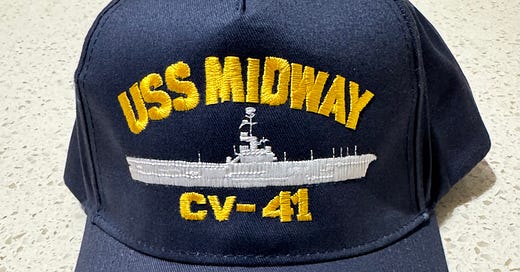It’s a weekend in San Diego but not a day off. The Western Naval History Association, a six year old organisation I have the privilege of serving with, holds their annual symposium on the USS Midway along the waterfront San Diego.
It’s actually the USS Midway Museum as a functioning site for hundreds of thousands to visit in appreciating what an aircraft carrier meant as far back as World War II. The ship obviously takes its name from what arguably was the most famous naval victory in our history, the June 1942 defeat of Japan at Midway Island in the central Pacific. The 200,000 sailors, including my husband and a number of colleagues, who deployed proudly on this carrier over its service receive broad smiles from the docents when they return to the ship.
By today’s standards, this ship is not as enormous as current successors. The most recent carrier built, the USS Gerald Ford (CVN 78), displaces 100,000 tons at 1092 feet long while the Midway (CV 41) displaced 64,000 tons in 1001 feet length when decommissioned in 1992 following 47 years of active service. Technology changed, missions expanded, and most relevantly the time we take to construct ships is much longer today than it was when we commissioned Midway in 1945. The Ford took eight years to commission in 2017 while Midway a mere 23 months following laying the ship’s keel.
Midway was the largest warship in the world when it could not transit the Panama Canal in 1955. It powerfully illustrated the globalisation of national security through its history as we deployed the carrier through the Cold War when we saw the need to show an enduring presence around the globe to protect our interests. Soviet threats worried U.S. strategists across the Pacific, leading to conflicts in Korea and Southeast Asia while generating profound anxiety about Japan, Taiwan, and other U.S. allies (following the signing of a series of mutual defense treaties in 1954 under the Eisenhower administration).
Keep reading with a 7-day free trial
Subscribe to Actions create consequences to keep reading this post and get 7 days of free access to the full post archives.




